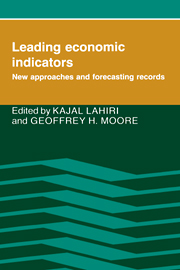Book contents
- Frontmatter
- Contents
- Preface
- List of contributors
- 1 Introduction
- PART I NEW CONCEPTS AND METHODS
- 2 Toward a theory of leading indicators
- 3 A time-series framework for the study of leading indicators
- 4 A probability model of the coincident economic indicators
- 5 An international application of Neftci's probability approach for signaling growth recessions and recoveries using turning point indicators
- 6 On predicting the stage of the business cycle
- 7 Bayesian methods for forecasting turning points in economic time-series: Sensitivity of forecasts to asymmetry of loss structures
- 8 New developments in leading indicators
- PART II FORECASTING RECORDS AND METHODS OF EVALUATION
- PART III NEW ECONOMIC INDICATORS
- Index
4 - A probability model of the coincident economic indicators
Published online by Cambridge University Press: 05 June 2012
- Frontmatter
- Contents
- Preface
- List of contributors
- 1 Introduction
- PART I NEW CONCEPTS AND METHODS
- 2 Toward a theory of leading indicators
- 3 A time-series framework for the study of leading indicators
- 4 A probability model of the coincident economic indicators
- 5 An international application of Neftci's probability approach for signaling growth recessions and recoveries using turning point indicators
- 6 On predicting the stage of the business cycle
- 7 Bayesian methods for forecasting turning points in economic time-series: Sensitivity of forecasts to asymmetry of loss structures
- 8 New developments in leading indicators
- PART II FORECASTING RECORDS AND METHODS OF EVALUATION
- PART III NEW ECONOMIC INDICATORS
- Index
Summary
Since their initial development in 1938 by Wesley Mitchell, Arthur Burns, and their colleagues at the National Bureau of Economic Research, the Composite Indexes of Coincident and Leading Economic Indicators have played an important role in summarizing the state of macroeconomic activity. This chapter reconsiders the problem of constructing an index of coincident indicators. We will use the techniques of modern time-series analysis to develop an explicit probability model of the four coincident variables that make up the Index of Coincident Economic Indicators (CEI) currently compiled by the Department of Commerce (DOC). This probability model provides a framework for computing an alternative coincident index. As it turns out, this alternative index is quantitatively similar to the DOC index. Thus this probability model provides a formal statistical rationalization for, and interpretation of, the construction of the DOC CEI. This alternative interpretation complements that provided by the methodology developed by Mitchell and Burns (1938) and applied by, for example, Zarnowitz and Boschan (1975).
The model adopted in this chapter is based on the notion that the comovements in many macroeconomic variables have a common element that can be captured by a single underlying, unobserved variable. In the abstract, this variable represents the general “state of the economy.” The problem is to estimate the current state of the economy, that is, this common element in the fluctuations of key aggregate time-series variables. This unobserved variable – the state of the economy – must be defined before any attempt can be made to estimate it.
- Type
- Chapter
- Information
- Leading Economic IndicatorsNew Approaches and Forecasting Records, pp. 63 - 90Publisher: Cambridge University PressPrint publication year: 1991
- 209
- Cited by



